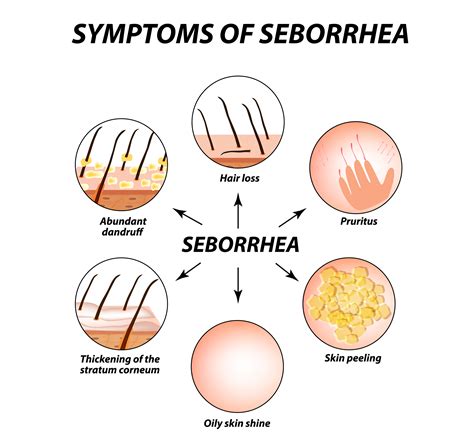Seborrheic Dermatitis: Symptoms, Causes, and Treatment
Seborrheic Dermatitis FAQ
What causes seborrhoeic dermatitis?
Conditions that are associated with increased rates of seborrhoeic dermatitis include individuals with HIV, hepatitis C, alcoholic pancreatitis, Parkinson's disease, and alcohol abuse. Seborrhoeic dermatitis is common in people with alcoholism, between 7 and 11 percent, which is twice the normal expected occurrence.
What is seborrheic dermatitis?
Seborrheic (seb-o-REE-ik) dermatitis is a common skin condition that mainly affects your scalp. It causes scaly patches, inflamed skin and stubborn dandruff. It usually affects oily areas of the body, such as the face, sides of the nose, eyebrows, ears, eyelids and chest.
What is the difference between psoriasis and seborrheic dermatitis?
Psoriasis and seborrheic dermatitis can mimic each other. Both are patches of red skin with flakes. Both can be found on your scalp and back. Psoriasis is an inflammatory skin disease that affects 2% to 4% of the population. The scales of psoriasis are often thicker than that of seborrheic dermatitis.
What is seborrhoeic eczema?
It’s also known as seborrhoeic eczema. Seborrhoeic dermatitis causes inflammation in areas of your skin that have a lot of sebaceous glands. These glands make an oily fluid called sebum, which keeps your skin supple. Areas of skin where you have lots of sebaceous glands include your face, scalp and chest.
Where does seborrhoeic dermatitis occur?
These include your armpits, under your breasts and your groin. These are areas that tend to stay moist. Seborrhoeic dermatitis affects up to 5 in every 100 adults. Around half of adults have dandruff, which is a mild, non-inflammatory form of seborrhoeic dermatitis that affects your scalp.
What is the difference between dermatitis & seborrhoeic dermatitis?
‘Dermatitis’ is a red, itchy, flaky (inflamed) skin complaint; ‘seborrhoeic’ means that the rash affects greasy (sebaceous) skin zones such as the face, scalp and centre of the chest. Seborrhoeic dermatitis is very common and many people don’t even know they have it.
Are there different types of seborrhoeic dermatitis?
There are infantile and adult forms of seborrhoeic dermatitis. This benign inflammatory condition is sometimes associated with psoriasis and is known as sebopsoriasis. Seborrhoeic dermatitis is also known as seborrhoeic eczema (“seborrheic” in American English).
Is seborrhoeic dermatitis a life threatening condition?
As an adult, seborrhoeic dermatitis is something that you will have for life. However, your symptoms may come and go over time. You can often deal with mild symptoms such as dandruff by yourself. You can also get advice from a pharmacist. But if your symptoms are severe or cover a lot of your skin, contact your GP for advice.
Seborrheic Dermatitis References
If you want to know more about Seborrheic Dermatitis, consider exploring links below:
What Is Seborrheic Dermatitis
- https://www.mayoclinic.org/diseases-conditions/seborrheic-dermatitis/symptoms-causes/syc-20352710
- https://nationaleczema.org/eczema/types-of-eczema/seborrheic-dermatitis/
- https://www.bupa.co.uk/health-information/healthy-skin/seborrhoeic-dermatitis
- https://dermnetnz.org/topics/seborrhoeic-dermatitis
- https://my.clevelandclinic.org/health/diseases/14403-seborrheic-dermatitis
- https://patient.info/skin-conditions/seborrhoeic-dermatitis-leaflet
- https://www.verywellhealth.com/seborrheic-dermatitis-7105838
- https://en.wikipedia.org/wiki/Seborrhoeic_dermatitis
- https://www.aad.org/public/diseases/scaly-skin/seborrheic-dermatitis
Seborrheic Dermatitis Information
Explore Related Topics
What factors should be considered when choosing a hair transplant clinic?
Share your thoughts and experiences on the essential factors to consider when selecting a hair transplant clinic and learn from others' recommendations.
What are the key differences between Platelet-Rich Plasma (PRP) Therapy and hair transplant surgery for hair loss?
Compare and contrast the benefits, drawbacks, and suitability of PRP Therapy and hair transplant surgery as means of combating hair loss.
SMP for Receding Hairlines: Realistic Expectations?
Converse about the effectiveness and expectations of SMP in addressing receding hairlines. Share success stories and opinions on its use for this specific concern.
Can saw palmetto be used as a natural remedy for hair loss?
Discuss the potential effects of saw palmetto on hair loss prevention and hair growth. Share your knowledge, personal experiences, and any precautions one should take with this herb.
Does scalp massage have any impact on hair loss?
Share and learn about the benefits of scalp massage for hair growth and preventing hair loss. Discuss techniques, oils, and tools that can enhance the effectiveness of scalp massage.
Are Oral Medications Safer Than Topical Treatments for Hair Loss?
Discuss the safety aspects of oral medications versus topical treatments for hair loss. Share your opinions and experiences regarding effectiveness and ease of use.
Is a protein-rich diet the secret to preventing hair loss?
Dive into the debate on whether increasing your protein intake can help prevent hair loss and promote thicker, healthier hair.
